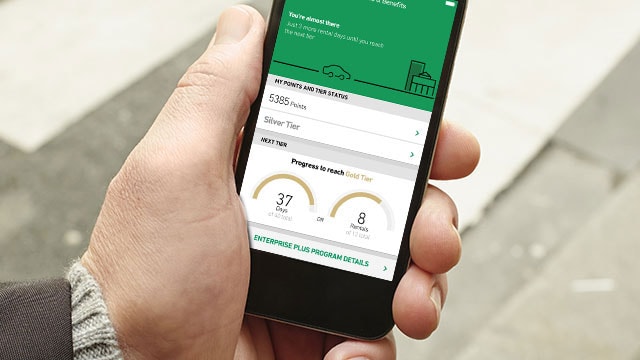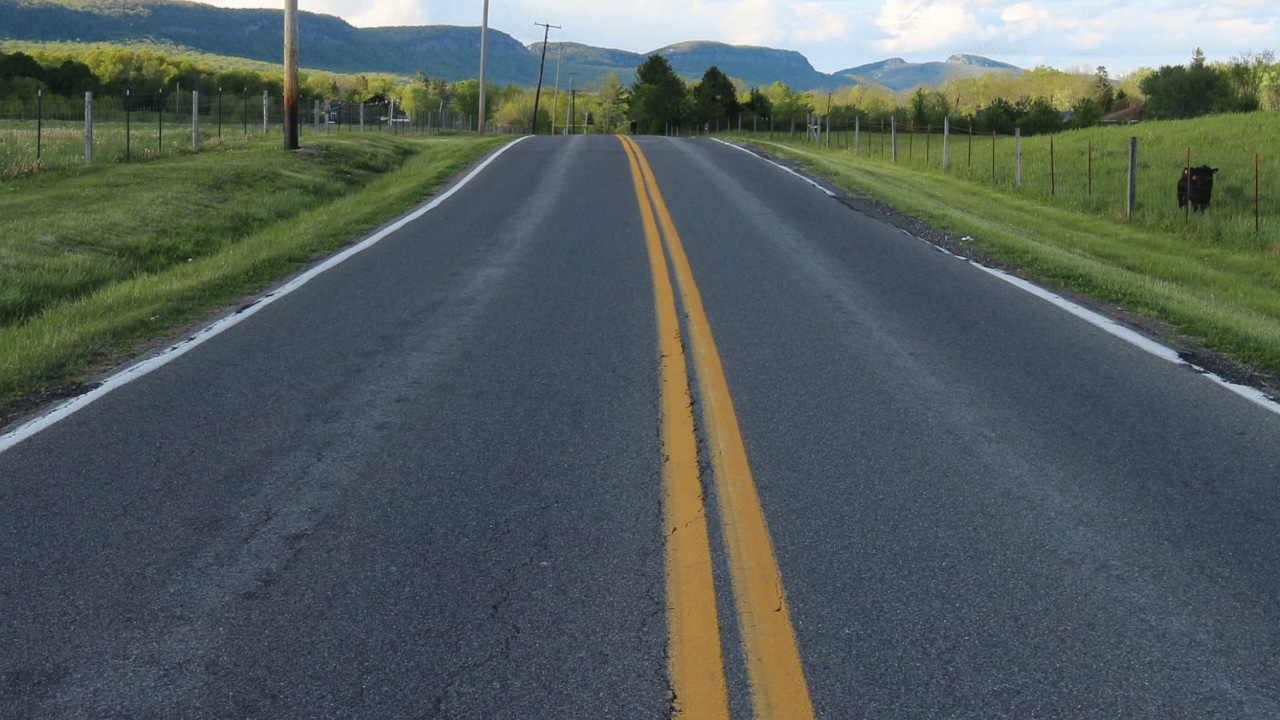Iceland Ring Road Itinerary
An Iceland Ring Road trip belongs on every adventurer's bucket list. The route, which follows the Þjóðvegur 1 highway, is named “Ring Road” because it hugs the coastline around the entire island. If you plan to take this journey, you'll explore the entire country and see some of its most gorgeous sights. Travelers who leave at the right time of the year may even get to see the northern lights! Follow this seven-day itinerary for an incredible Iceland Ring Road tour. Get your trip started with a rental car at Keflavik Airport (KEF) located roughly 45 minutes from the city center or at one of two additional locations downtown.
Drive time around the Ring Road (straight through): approximately 15 hours
Distance around the Ring Road: approximately 828 miles
Best car for this road trip: SUV (required to access the country's inland F roads)
1. Reykjavík
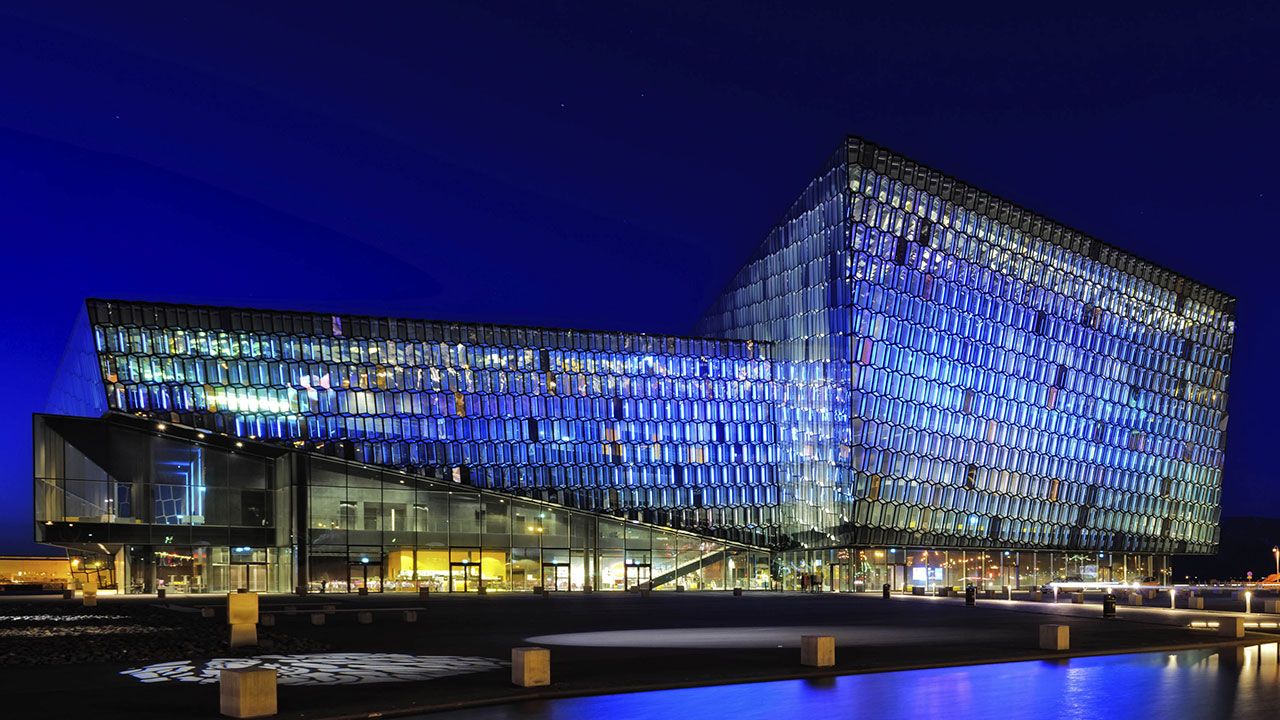
Harpa Concert Hall
Since traveling the Ring Road in Iceland takes you in one big circle, you'll start and end your trip in Reykjavík, which is the country's capital and its largest city. The port city is on the southwestern shores of Iceland. If you want to do some sightseeing before hitting the road, stop by Hallgrímskirkja, the nation's largest church, and Harpa, a glass honeycomb concert hall. Both are stunning examples of modern architecture.
With so many amazing landscapes, small towns, and attractions along Ring Road, Iceland adventurers can easily turn a seven-day trip into a two-week journey or longer. To stick to a weeklong plan, however, you'll have to tear yourself away from the sights in Reykjavík and log some hours driving on Ring Road. Of course, time spent behind the wheel in Iceland is easy to cherish. The parts that are closer to the ocean offer views of the sea and fjords, and on any clear day anywhere on Ring Road, you'll see Iceland's picturesque volcanic mountains and green fields.
The drive from Reykjavík to Vik covers roughly 112 miles and takes about 2.25 hours. You'll briefly head toward Þjóðvegur 1 via Route 49 from Reykjavík, but once you're on Ring Road, you just keep heading south to reach Vik.
2. Vik
Vik is a small seaside village, and though you won't find major tourist attractions or things like museums and galleries, you'll want to stop off to see some of Iceland's most beautiful sea cliffs. Two are within a short drive of the village: Reynisfjara and Dyrhólaey. You can also go to Reynisfjara Beach to see the unique cliff landforms. This is also a popular location to watch the northern lights, with the Dyrhólaey lighthouse serving as an amazing backdrop.
Vik has an impressive number of quality restaurants for such a small village. One of the top rated is Restaurant Sudur Vik, which is within walking distance of the sea cliffs. Stop in for entrees like beef ribeye and a fillet of lamb.
Driving from Vik to your next stop, Hof, takes about two hours and spans roughly 96 miles. This isn't much time on the road, so you'll have plenty of room in your schedule to walk on the beach and take photos of the unique architecture and natural splendor along the way.
3. Hof
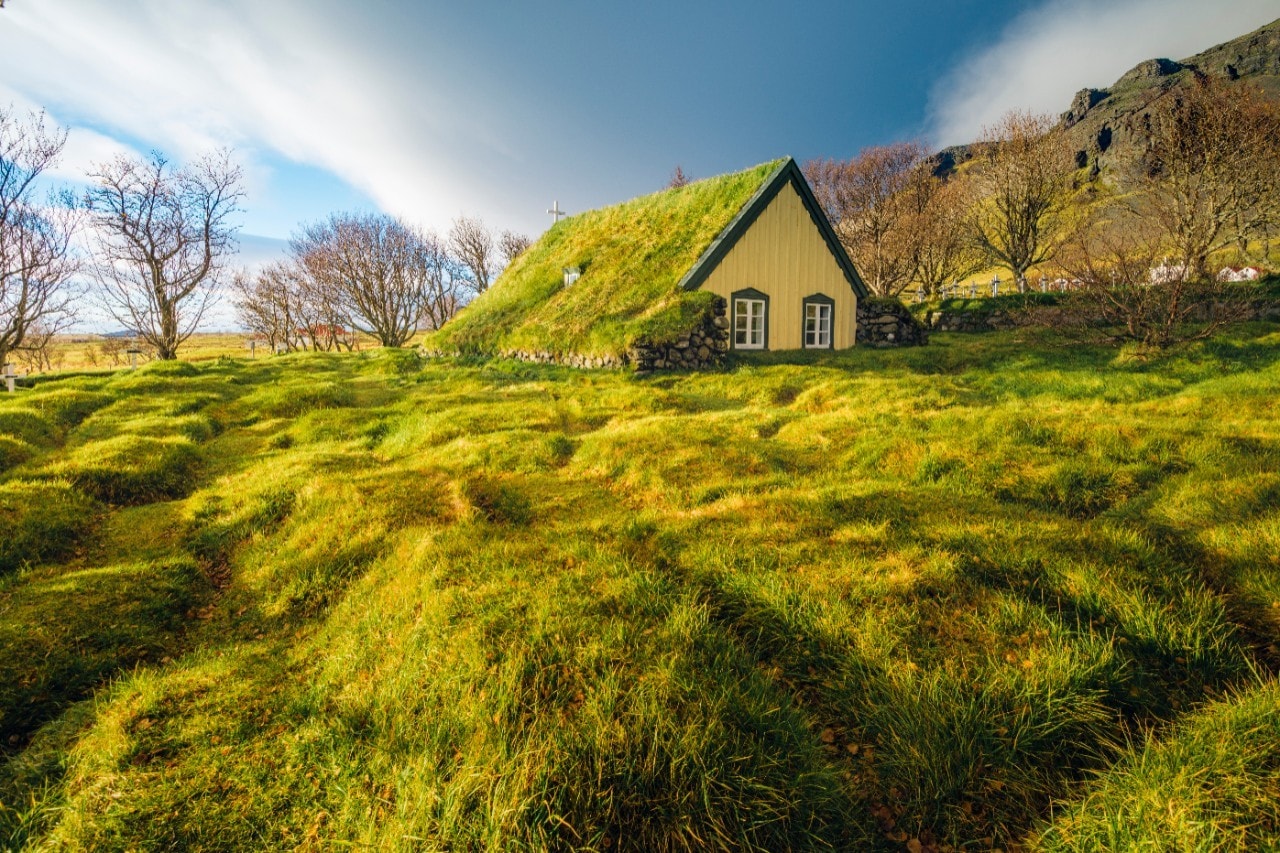
Hof Turf Church
Hof, another small community, is a cluster of farms best known for its turf churches. These were constructed centuries ago, with the architectural design serving to protect the building from the nation's harsh climate. The Hofskirkja Church still stands and is a popular stop for photos. The building operates as a parish church to this day.
You can also access Skaftafell from Hof. This is part of the Vatnajökull National Park, so if you want to hike on your trip, this is one of the best areas to go to. You'll get to see Iceland's towering volcanoes, glaciers, and waterfalls. The village has several wooden cabins, quaint hotels, and campgrounds, making Hof a good place for some rest.
Hof to Höfn is another short drive that will take you about 1.5 hours. This 74-mile route runs south between Vatnajökull National Park and the coast, making it one of the most scenic parts of the seven-day journey.
4. Höfn
Höfn is a coastal fishing town near Hornafjörður fjord. It's another great place to rest while watching the northern lights, and you'll also be treated to uninterrupted views of Vatnajökull. Like Hof, you'll find hotels, cabins, and campgrounds nearby.
If you want to learn more about this part of Iceland, stop at Gamlabúð Visitor Center. Here you can pick up brochures and maps of nearby Vatnajökull National Park. On the second floor, you'll find exhibits documenting the area's history. For food, check out Pakkhús Restaurant. The eatery has an open floor plan, which creates a welcoming, warm atmosphere.
Once you're rested and fed, hop back in the car for a drive from Höfn to Reykjahlíð. This part of the trip covers over 217 miles and takes about 4.75 hours of driving. You'll pass the eastern shores of the island and cross over several bridges.
5. Reykjahlíð
Ready to swim? Reykjahlíð, a village bordering the large lake Mývatn, is a popular spot thanks to its nature baths (Jardbodin Vid Mytvan). The nearby volcanoes heat these baths, so people flock here in the winter to warm up in the mineral-rich springs. Stóragjá, an ancient cave complex, is another location where you can find hot springs near Reykjahlíð.
The next driving portion of your trip will take you from Reykjahlíð to Akureyri. You'll be on the road for about 63 miles and 1.5 hours.
6. Akureyri
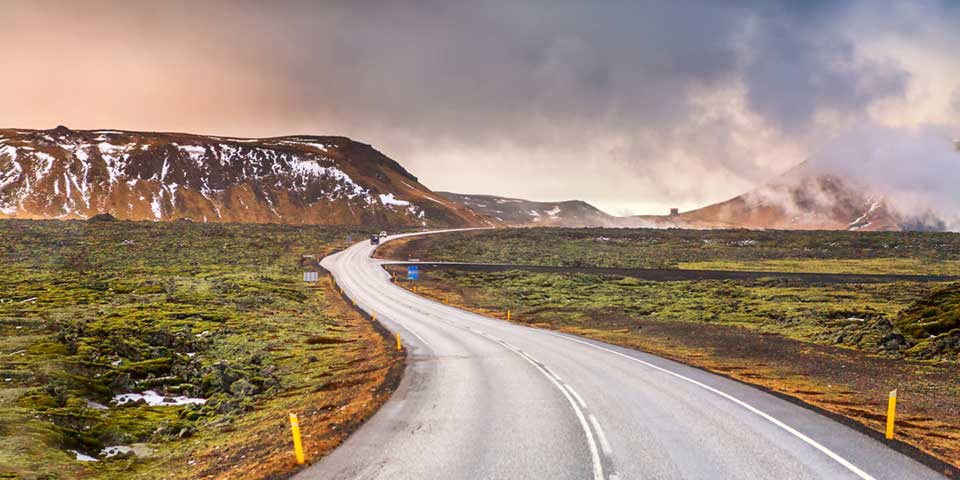
Iceland Ring Road
Akureyri is a cultural center in Iceland known for its views of Eyjafjörður Fjord and numerous attractions. You can visit a beautiful 1940s church known for its stained-glass windows and Icelandic Christian history. For more art and culture, explore the Akureyri Art Museum, where you can see contemporary works from local artists. Be sure to set aside some time to walk through the Akureyri Botanical Garden as well.
Akureyri to Borgarnes is approximately a 193-mile, 3.5-hour drive. If you have time, stop between Akureyri and Borgarnes for a detour past Reykholt toward Kalmanstunga. Though it's off Ring Road, this route will take you near Hraunfossar — one of Iceland's best waterfalls.
7. Borgarnes
Borgarnes is the last stop before completing the Ring Road circuit. Unwind at the shores of Borgarfjörður, where you can see puffins and a scenic waterfall. If you're interested in Icelandic history, visit Skallagrim's Burial Mound — the memorial of a legendary Viking.
After exploring Borgarnes or seeing the falls in Hraunfossar, you'll get back on Ring Road for the last leg of your trip. The drive from Borgarnes back to Reykjavík takes roughly one hour, covering 43 miles. Take some time to relax from the long drive at the Blue Lagoon, located just outside of the city center.
Or, you could continue your journey and visit the Golden Circle. This three-stop route features a national park, a large geyser, and a beautiful waterfall. The first stop of the Golden Circle, Thingvellir National Park, is about 55 miles from Borgarnes, which would take you just over an hour to reach.
8. Thingvellir National Park
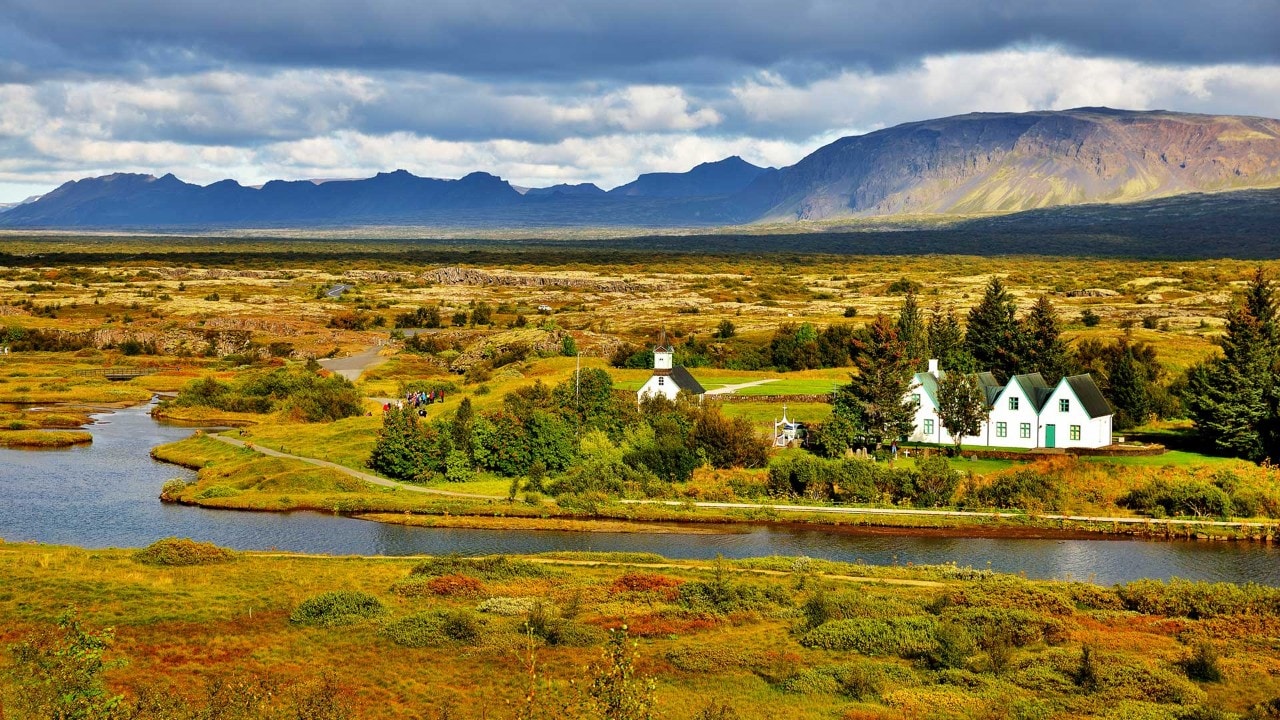
A church in Thingvellir National Park
Iceland is home to three national parks, though Thingvellir is the only one that is classified as a UNESCO World Heritage Site. It is considered a historic landmark, as Iceland's democratic parliament was founded here. This park is also a geological wonder. It's situated within a rift valley, which was created when the North American and Eurasian tectonic plates began separating from one another.
While you're in Thingvellir National Park, be sure to stop and see the one and only waterfall, Öxarárfoss. This waterfall was actually man-made in order to provide easier access to water following a diversion that took place hundreds of years ago. Today, it serves as a beautiful rocky site along the eastern end of the park's fault line.
Another popular spot in the park is the historic Lögberg, also called the Law Rock. Although its exact location is unknown, historians do know that the Althing parliament assemblies took place in its general area. The rock provides stunning views over the Thingvellir area.
9. Geysir
About an hour east of Thingvellir is Geysir, a large hot spring area located in the Haukadalur Valley. Not only will you find geysers here, but this area is also a wonderful vantage point for viewing the northern lights or the midnight sun.
Although the Great Geysir itself has not erupted in several decades, you do have other options if you want to see a live geyser. About a mile away, you'll find Strokkur. This geyser erupts about every ten minutes, shooting water over 100 feet into the air, so you're sure to catch a spout on your stop.
When you're finished watching Strokkur, head over to the Geysir Center right across the street. Inside is a restaurant, an ice cream shop, plus stores full of souvenirs and Iceland-exclusive brands.
Iceland Ring Road FAQs
It takes about 15 hours, covering 828 miles, to complete the Ring Road loop in good weather with minimal stops. You'll want to set aside much more time for exploring, though. Finishing Iceland Ring Road in seven days will give you sufficient time to pause and see the sights.
The best driving conditions are in the summer and spring. However, if you're willing to add some extra days to your journey and don't mind adventuring at a slower pace, fall and winter are lovely, as well. Dress warm for the winter, though — temperatures drop into the 20s.
Driving Iceland Ring Road is straightforward. This is the country's main route, so it's well-maintained. The speed limit is 90 kilometers in most areas (approximately 56 miles per hour), and Ring Road has two lanes excluding a few one-lane bridges. Just learn about Iceland's special traffic signs and check the road conditions before leaving.
The northern lights are visible from September through April, depending on the weather and solar activity.
Any visit to Iceland will leave you breathless, whether you hike deep into Vatnajökull National Park or just spend an afternoon shopping in Reykjavík. The nation has an incredible mix of modern attractions and rural beauty, and the best part of your trip will easily be pausing to enjoy the view — especially if you get a chance to see the northern lights.

